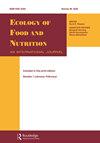一项混合方法研究,旨在了解佛罗里达州坦帕市服务不足社区居民的饮食环境和杂货店购物模式。
IF 1.7
4区 医学
Q4 NUTRITION & DIETETICS
Ecology of Food and Nutrition
Pub Date : 2021-07-01
Epub Date: 2020-12-23
DOI:10.1080/03670244.2020.1862098
引用次数: 0
摘要
为了更好地了解食品获取情况、食品零售店环境以及社区居民对其杂货店购物模式的看法,以及在服务不足、以非洲裔美国人为主的社区中获取健康食品的情况,我们开展了一项混合方法研究。研究采用了地理信息系统制图、杂货店观察(n = 4)、食品获取和杂货店环境调查(n = 126)以及焦点小组(n = 48)等方法。结果表明,这些社区的杂货店密度较低,四家杂货店中只有两家符合健康零售店的标准。本文讨论了获取健康食品的障碍以及改善食品获取的解决方案。本文章由计算机程序翻译,如有差异,请以英文原文为准。
A Mixed-methods Study to Understand Food Environments and Grocery Shopping Patterns of Community Residents in Underserved Neighborhoods in Tampa, Florida.
A mixed methods study was conducted to better understand food access, food retail store environment, and perspectives of community residents on their grocery store shopping patterns and access to healthy foods in underserved, predominantly African American neighborhoods. GIS mapping, grocery store observations (n = 4), a food access and grocery store environment survey (n = 126), and focus groups (n = 48) were used. The results indicate that these neighborhoods have a low density of grocery stores, and only two out of four grocery stores meet the standard for a healthy retail store. Barriers to getting healthy foods and solutions to improve food access are discussed.
求助全文
通过发布文献求助,成功后即可免费获取论文全文。
去求助
来源期刊
CiteScore
3.50
自引率
0.00%
发文量
23
审稿时长
>12 weeks
期刊介绍:
Ecology of Food and Nutrition is an international journal of food and nutrition in the broadest sense. The journal publishes peer-reviewed articles on all aspects of food and nutrition -- ecological, biological, and cultural. Ecology of Food and Nutrition strives to become a forum for disseminating scholarly information on the holistic and cross-cultural dimensions of the study of food and nutrition. It emphasizes foods and food systems not only in terms of their utilization to satisfy human nutritional needs and health, but also to promote and contest social and cultural identity. The content scope is thus wide -- articles may focus on the relationship between food and nutrition, food taboos and preferences, ecology and political economy of food, the evolution of human nutrition, changes in food habits, food technology and marketing, food and identity, and food sustainability. Additionally, articles focusing on the application of theories and methods to address contemporary food and nutrition problems are encouraged. Questions of the relationship between food/nutrition and culture are as germane to the journal as analyses of the interactions among nutrition and environment, infection and human health.

 求助内容:
求助内容: 应助结果提醒方式:
应助结果提醒方式:


